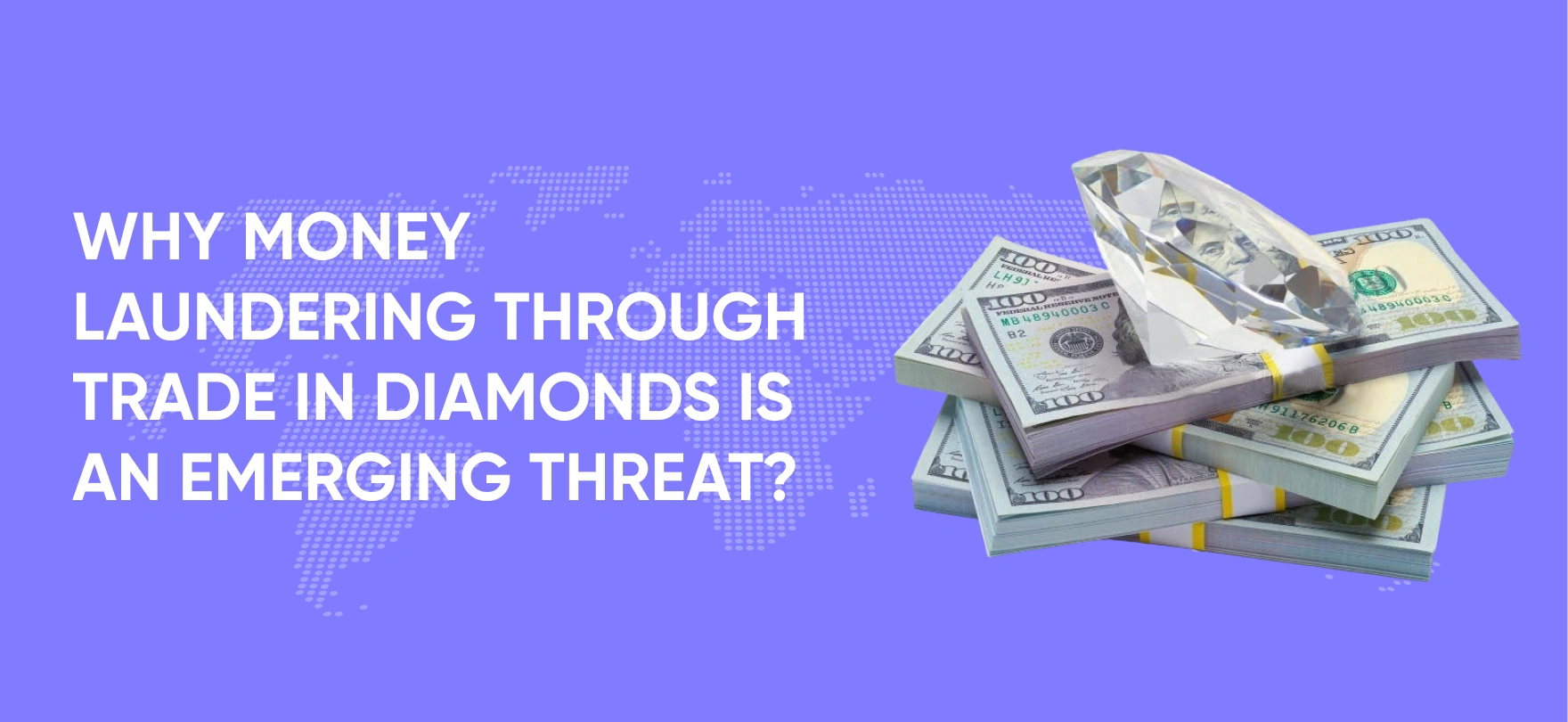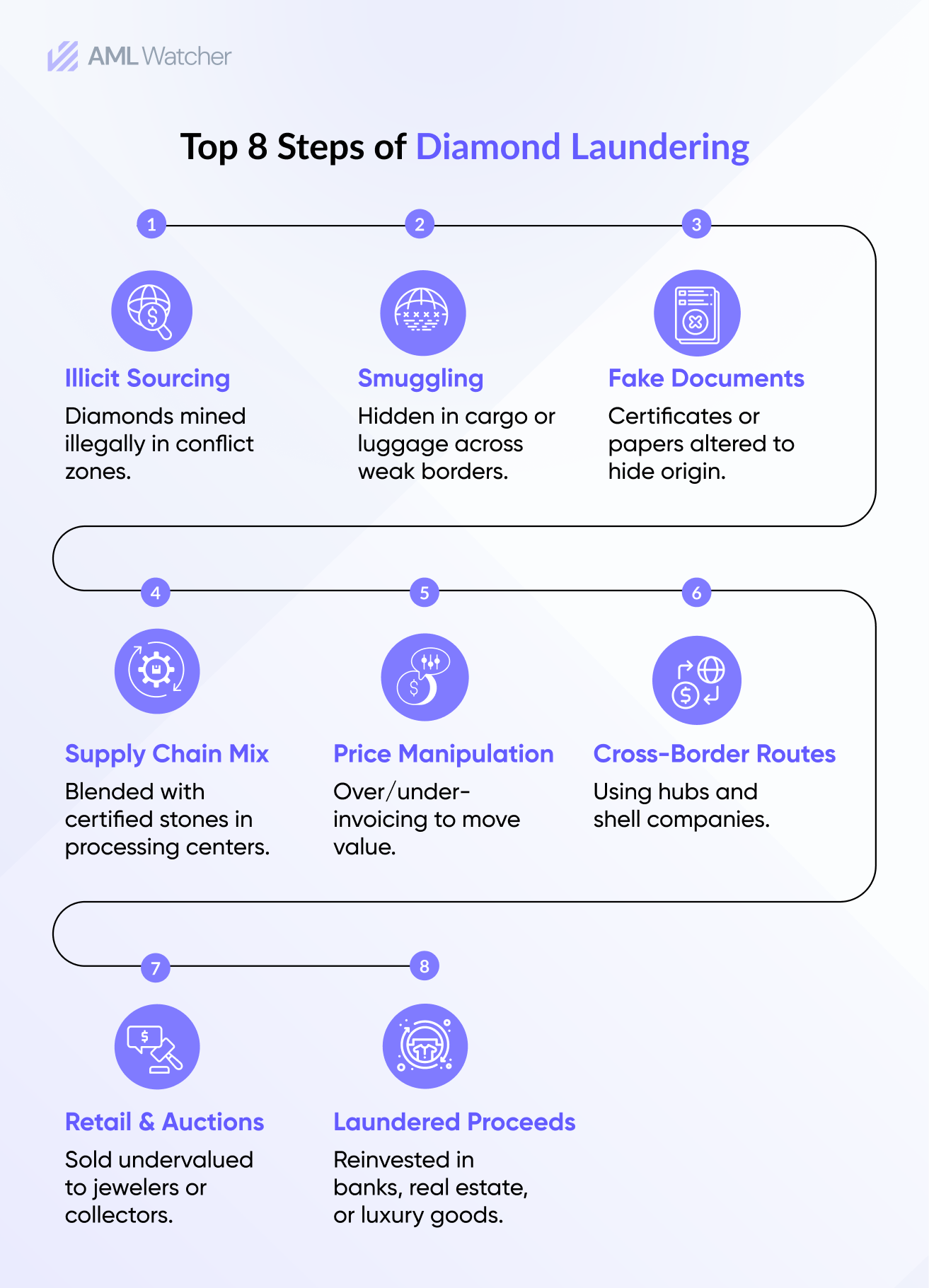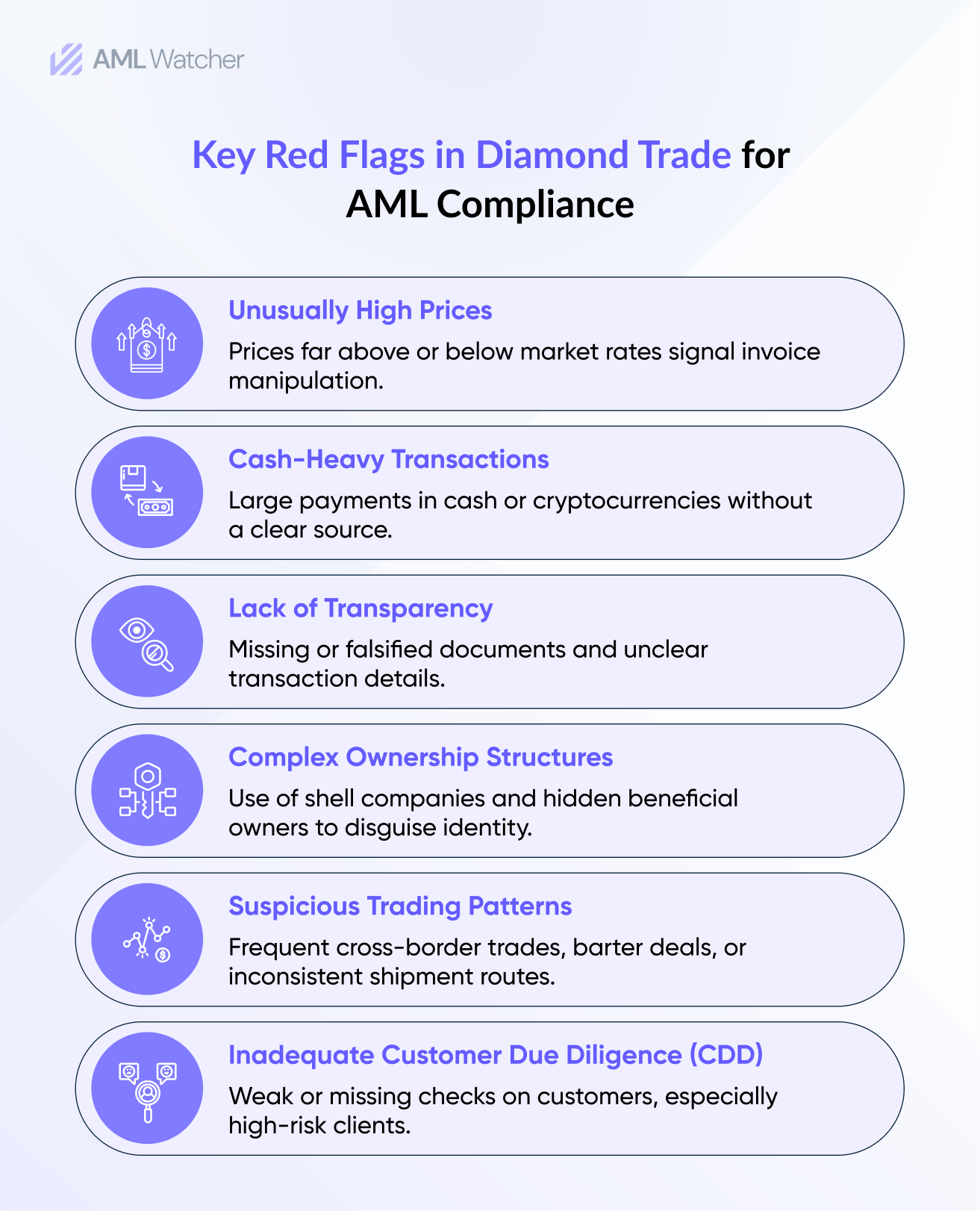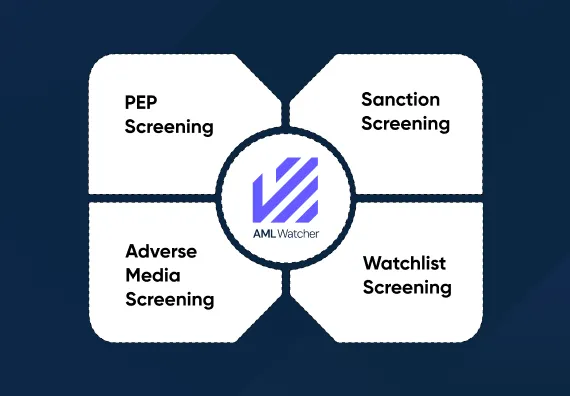
Why Money Laundering Through Trade in Diamonds is an Emerging Threat?
Diamonds can conceal billions without leaving a trace. For centuries, these gems have been a source of wealth and prestige. But in today’s global trade, they also serve as a discreet vehicle for illicit value transfer. Their small size, high value, and opaque pricing now make them an attractive tool for laundering illicit funds through illegal trades like diamond drug exchanges and smuggling networks.
In 2022, the global diamond production was reported at 121 million carats, highlighting the sector’s vast scale and the opportunities it offers to criminals.
The Financial Action Task Force (FATF) defines trade-based money laundering (TBML) as concealing criminal proceeds and moving value through trade transactions to make illicit funds appear legitimate; a definition that fits the diamond trade precisely.
Such illicit trading continues to expand despite all the global efforts that aim to stop it because the static AML systems are not capable enough to tackle the weaknesses within the diamond supply chain.
As FATF in its “Money Laundering and Terrorist Financing Through Trade in Diamonds” report states that, “The portability of diamonds with such high value, no standardized price quotation attached, makes them particularly vulnerable to misuse such as money laundering or terrorist financing.”
The Hidden Vulnerabilities in Diamond Trading
The diamond trade involves auctions, exports, wholesale, and retail networks. These complex global networks bridge financial hubs and high-risk jurisdictions. Amid this global mesh, the trade provides opportunities for abuse.
Trade-Based Money Laundering (TBML)
One of the diamond trade’s significant vulnerabilities is its exposure to TBML. Here, criminal entities manipulate invoices for diamond trading transactions under- or over-invoicing to obscure illicit value transfers. The diamond trade operates with pricing guidelines, but lacks full transparency and standardized, universally enforced pricing.
Case 1: Invoice Manipulation & Transnational Syndicates
For instance, in December 2023, the Directorate of Revenue Intelligence (DRI) found cases where cheap synthetic diamonds imported from Hong Kong were declared as natural diamonds and overpriced by more than 100 times. The trade was a cover for a money laundering scheme involving the export of foreign exchange out of India through banking channels.
As a result, Indian Customs seized the goods involved and arrested four individuals. This meant that regular trade invoices were used to transfer illegal funds across borders. Simultaneously, Hong Kong Customs declared investigations into a transnational money laundering syndicate that laundered HK$500 million through trade in diamonds. The news came out after the customs authorities arrested four individuals, seized HK$1 million in cash, and froze another HK$8.2 million in accounts of suspects.
Case 2: Diamonds as a Currency
In another case in 2005, Roman Nektalov, a gold and diamond dealer, was sentenced to 10 months in prison for money laundering. An undercover investigation, codenamed “Operation Meltdown” by the Federal Bureau of Investigation (FBI), revealed Nektalov exchanged narcotics proceeds ($500,000) for diamonds. The case fell under U.S. federal jurisdiction in the Southern District of New York, prosecuted by the U.S. Department of Justice (DOJ). The sting operation occurred in the early 2000s, with conviction and sentencing in 2006.
These schemes highlight the vulnerability in the diamond trade due to its high value, subjective price, portability, and inadequate customer due diligence.
Black Market Diamonds and Smuggling
Even though there are some internationally known systems, such as the Kimberley Process Certification Scheme (KPCS), that are established to prevent “conflict diamonds” from entering the mainstream global diamond trade network, illegal gems are still getting into the legitimate markets.
The diamond smuggling market comprises up to 20% of the global diamond trade, with conflict diamonds alone accounting for as much as 15% at the height of the 1990s crisis.
Smugglers take advantage of weak borders and untrustworthy traders to move conflict diamonds, often using falsified documentation and complicit intermediaries to avoid established checks and protocols.
As noted in FATF’s 2013 report on trade in diamonds, even certified stones can be misused once they re-enter the supply chain post-laundering, making traceability a persistent problem.
Because of the Kimberley Process, some industry estimates say that the share of conflict diamonds in the market reduced from 15% to 1% as of 2007. Yet, they still enter the market through falsified documentation or complicit intermediaries.
How Diamonds are Used as a Medium for Illicit Value Transfer?
Diamonds are of high value, can be easily carried and traded anonymously, which positions them as an ideal substitute for cash. In areas where there is weak regulatory oversight, criminal networks have used diamonds to trade for arms or drugs, leaving no bank trail, no receipts, and no traditional red flags for compliance teams.
A United Nations Fowler Report (March 2000) documented how the Angolan rebel group UNITA traded diamonds for weapons instead of using money. From 1993–1997, diamond dealer Joe de Deker worked with Zaire’s government to supply UNITA with Eastern European arms in exchange for diamonds worth about $6 million. Since no money was involved, there was no financial record, which made it difficult for the banking sector to track the trade.
To curb such risks, many countries classify the precious gems and stones sector as a Designated Non-Financial Business or Profession (DNFBP), bringing it under AML/CTF regulations. Businesses in this sector must perform customer due diligence, report suspicious transactions, maintain records, and implement internal controls.
For example, in the UAE, dealers in precious metals and stones are regulated under Federal Decree-Law No. 20 of 2018 and Cabinet Decision No. 10 of 2019. They are required to register with the UAE Financial Intelligence Unit, conduct due diligence, report transactions above AED 55,000, and follow internal AML policies.
Why AML Compliance Remains a Challenge for Banks and Jewellers?
-
Inconsistent AML Program for Jewellers
In many jurisdictions, jewellers and dealers in precious metals and stones are not subject to as strict AML laws as are other financial institutions. This leads to inconsistencies in how they comply with the law. This gap raises serious concerns about the risk of money laundering in the jewellery industry. As a result, the standards for checking customers, particularly in high-risk transactions, are often weak and outdated.
Paying for expensive items with cash or cryptocurrency without verifying the origin of the funds can create opportunities for organized crime. FATF and UNODC have repeatedly pointed out that the dealers in precious stones and metals, including diamond traders, lack proper anti-money laundering (AML) practices and do not consistently follow effective due diligence processes.
-
Complex Beneficial Ownership Structures and Politically Exposed Persons (PEPs)
The diamond industry often deals with high-net-worth individuals and politically exposed persons (PEPs). Furthermore, the use of shell companies has also been observed in the trade of illicit diamonds. When ownership is hidden behind shell companies, it becomes hard for compliance teams to find out who really owns the business.
In 2018, Indian jeweller Nirav Modi and his associates exploited gaps in Punjab National Bank’s due diligence by using fraudulent Letters of Undertaking to move nearly $2 billion through diamond trade channels. The bank’s failure to detect these irregular transactions led to severe regulatory scrutiny, significant reputational damage, management shake-ups, and tighter compliance requirements across India’s banking sector. This case illustrates how weak AML controls in high-value goods transactions can expose financial institutions to large-scale fraud.
In the Central African Republic, United Nations experts and investigation groups have found that armed groups use diamond export channels to fund conflict and smuggling proceeds through countries with weak oversight.
To handle these risks, financial institutions should have AML compliance systems for customer due diligence, advanced screening of politically exposed persons (PEPs), detailed analysis of ownership structures, and mapping of relationships to find out the hidden criminal networks.
-
Sanction Compliance Issues Across Borders
Diamond trading moves through different steps across several jurisdictions, often from mining to cutting, trading, banking, and further shipping. Because at any point of the global supply chain, the pricing, documents, or shipping routes can be changed, making it challenging to track the trading precisely.
Dealing with jurisdictions with conflicting regulations increases the chance that firms may unintentionally work with the sanctioned entities. Without appropriate screening and comprehensive checks, firms could end up doing business with shell intermediaries or facilitators.
In 2023, the U.S. Treasury’s Office of Foreign Assets Control (OFAC) sanctioned 52 individuals and companies in the diamond trade for violating U.S. sanctions by helping sanctioned dealer Nazem Ahmad move diamonds and artwork worth hundreds of millions of dollars across borders.
The case illustrates how intermediaries and shell firms in multiple jurisdictions can mask a sanctioned entity’s involvement, showing why diamond traders must run thorough sanctions checks at every stage of the supply chain to avoid facilitating illicit financing.
To prevent such cases from damaging the diamond industry, effective AML compliance systems are a must-have.
How Criminals Use Creative Ways to Launder Money?
Money launderers constantly find new ways to take advantage of weaknesses in compliance. Some of the more creative methods criminals use to launder money are:
- Recycling conflict diamonds into legitimate supply chains via intermediaries
- Swapping diamonds for drugs in barter transactions with no money trail
- Over-invoicing diamond transactions through offshore subsidiaries to transfer value illicitly.
- Complicit auctioneers assist corrupt buyers by undervaluing gems.
These schemes take advantage of the complex and valuable diamond market. This makes it hard to monitor and requires constant human attention to spot them.
Regulatory Response and Gaps
The Kimberley Process has reduced the conflict diamond trading to a large extent since 2003. Yet, it still struggles with poor enforcement because the Process only covers rough diamonds; therefore, the polished ones go unnoticed, increasing the chances of money laundering.
FATF, in its mutual evaluations and typology reports, clearly guides countries like the UAE, India, and Israel that are key diamond hubs to reinforce their regulations for the non-financial businesses, such as gold and diamond dealers.
UAE’s National Risk Assessment focused on a similar point by warning the financial and non-financial businesses that diamonds are often used for money laundering.
How AML Watcher Supports Precious Stone Dealers and Financial Institutions?
Tackling money laundering in the diamond trade demands more than static compliance audits. With fragmented oversight, shell ownership, and secondary sanctions exposure deeply embedded in the industry, institutions now need real-time and comprehensive risk intelligence to accurately assess and mitigate risks before they escalate. There is no one-size-fits-all approach to managing risk in the diamond industry. AML Watcher’s AI-powered AML screening, based on comprehensive data, empowers businesses to filter the risk from actual customers.
It helps the compliance teams in:
- Due Diligence for High-Risk Customers: With 2.6 million+ PEP profiles across 235+ countries and jurisdictions, categorized by risk and role, jewellers and audit units can trace invisible connections between high-risk individuals, suspicious transactions, and complex ownership structures, even when disguised through intermediaries.
- Adverse Media, Warnings, and Regulatory Enforcement Screening: AML Watcher’s advanced adverse media screening flags high-risk customers linked to money laundering offences or organized crime and helps FIs in preventing the enforcement actions.
- Real-Time Monitoring: AML Watcher provides instant alerts for the high-risk entities that are sanctioned or have their names in adverse media, helping compliance teams catch risks early, even in complex cross-border trades.
Precious metals and stones dealers and FIs can ensure compliance with their domestic AML obligations and enhance operational resilience by integrating AML Watcher’s screening solutions.
We are here to consult you
Switch to AML Watcher today and reduce your current AML cost by 50% - no questions asked.
- Find right product and pricing for your business
- Get your current solution provider audit & minimise your changeover risk
- Gain expert insights with quick response time to your queries







